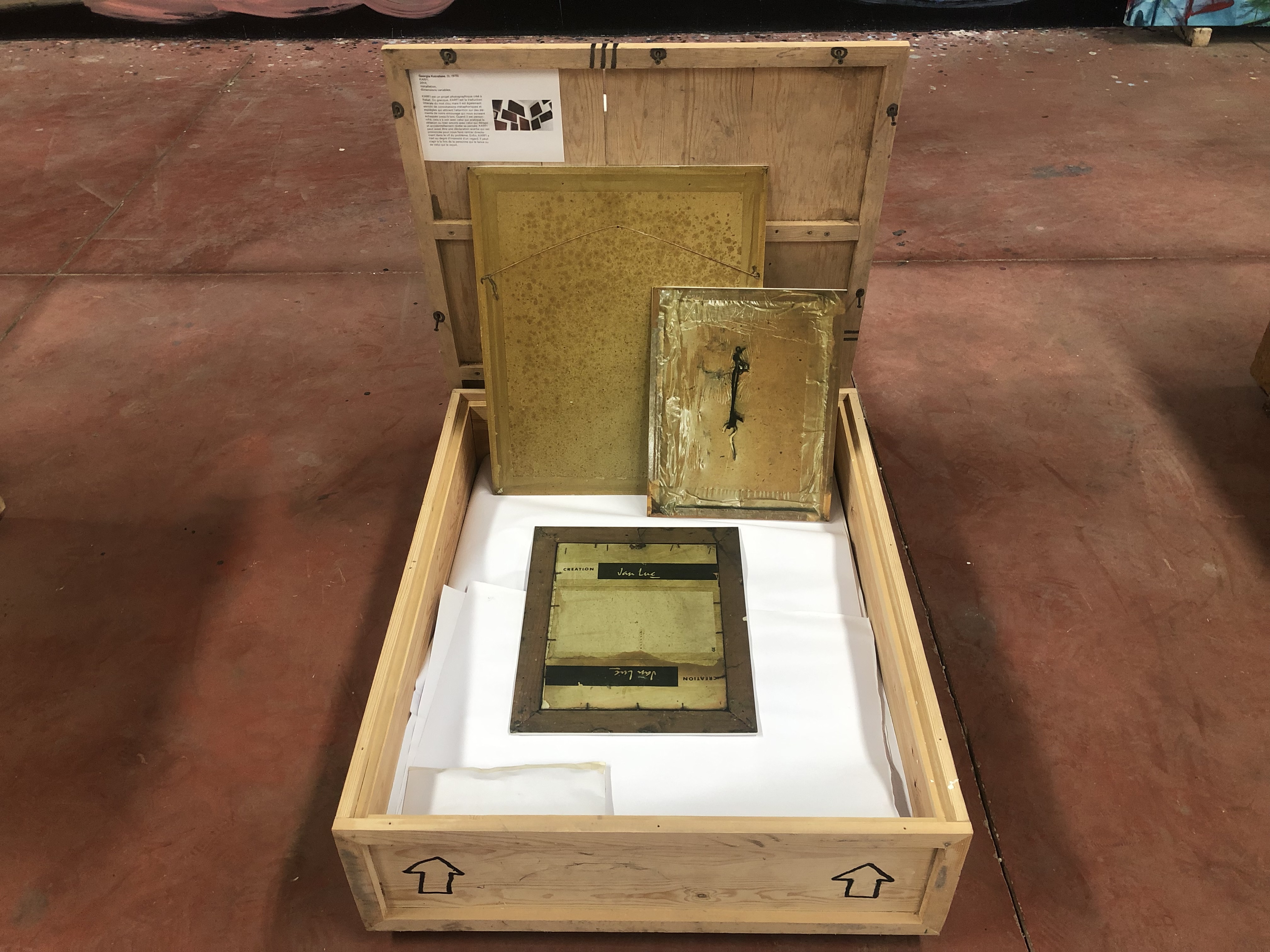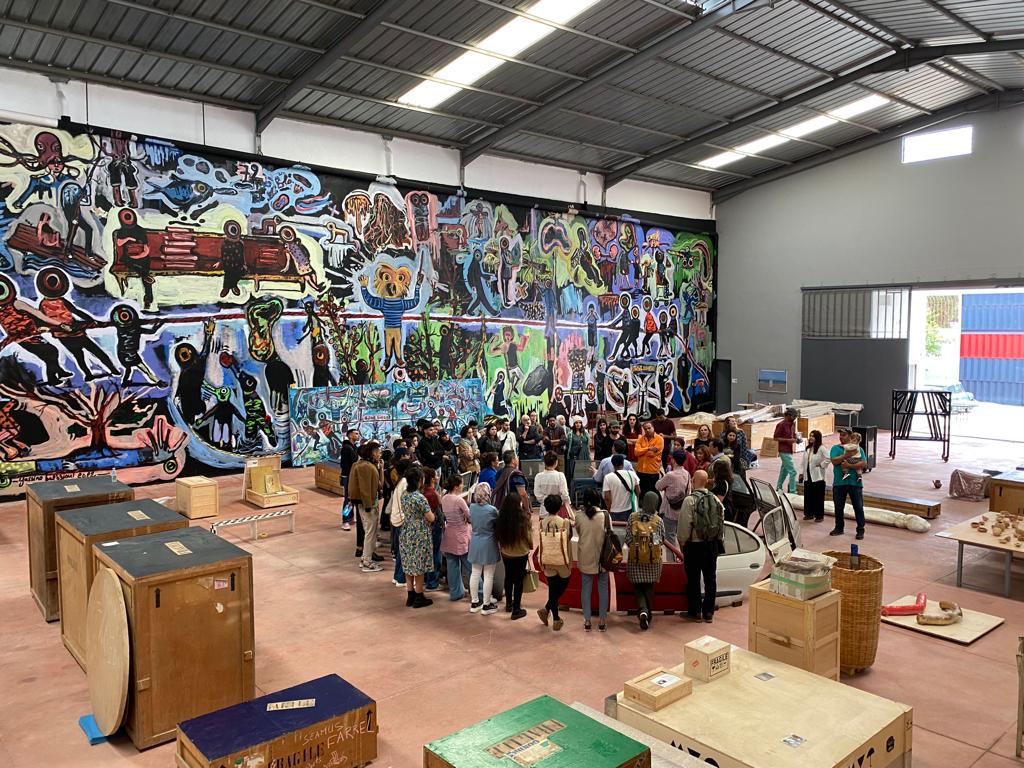Review #4: Familiarity
Anne Szefer Karlsen
“L’appartement 22 (2002-2022)” is a group exhibition curated by Abdellah Karroum, runs from 11 October 2022 until 07 January 2023 at Lot 219 - temporary space which has often served as backstage of experimentation and production of works in the industrial district of Bensouda in Fes. Are deployed in the place, works, archives and interventions of: Sofia Aguiar, Mustapha Akrim, Sadik Kwaish Alfraji, Francis Alÿs, Ahmed Amrani, Nassim Azarzar, Younes Baba-Ali, Yassine Balbzioui, Tina Barouti, Yto Barrada, Liliana Basarab, Faouzi Bensaïdi, Karima Boudou, Cecile Bourne-Farrell, Matti Braun, Gabriella Ciancimino, Philippe Cazal, Tomàs Colaço, Hassan Darsi, Pedro Gomez Egana, Mohamed El-Baz, Safaa Erruas, Ninar Esber, Seamus Farrell, Mounir Fatmi, Shezad Dawood, Pedro Gomez Egana, Heidi Nikolaisen, Chourouk Hriech, Natasha Ginwala, Badr El Hammami, Mohssin Harraki, Dominique Hurth, Fabrice Hyber, Soukaina Joual, Goddy Leye, Fadma Kaddouri, Maria Karim, Abdellah Karroum, Hyunjin Kim, Joseph Kosuth, Georgia Kotretsos , Miloud Labied, Otobong N'kanga , Sara O'Haddou, Syl. Pâris Kouton, Aurora Pellizzi, Bernard Plossu, Catherine Poncin, Karim Rafi, Raqs Media Collective, Mohammed Larbi Rahhali, Younes Rahmoun, Maria Camila Sanjinés, Jérôme Schlomoff, Pascal Semur, Anne Szefer Karlsen, Jean-Paul Thibeau, Cyprien Tokoudagba, Natalia Valencia Arango, Oriol Vilanova, Ala' Younis, James Webb, Sanaa Zaghoud.
"L’appartement 22 (2002-2022)" is a sprawling exhibition featuring works and traces from twenty years of art productions, collaborations, and conversations, that for the most part have happened during a large number of so-called "expeditions"1. I remember the location of the exhibition—Lot 219 in an industrial area of Fès, Morocco—from 2008. There was no roof, machines I don’t know the functions of, were stored there along with other mechanical remnants in the open air space. Today the space has a roof and is reminiscent of a "kunsthall" in its architecture.
As I enter the hall, I also remember the courtyard with its lemon tree, and the weirdly domestic feeling it provided to a space that was in transition from industrial to cultural. Now, just as then, the neighbour’s cock crows from time to time, and cats and dogs wander in and out—making sure that the space stays in-between industrial, cultural, and domestic. Today, however, the opening of the exhibition draws a crowd that requires us to see it as a cultural space; an understanding that is also provoked by the objects on display, the captions thoughtfully contextualising the art and the crates that house them, and the hospitality offered to us as visitors.
The mezzanine holds ephemera, documents and artworks that invoke the archive. It is like a study room, with tables and chairs. On the wall is a recurring image by Younes Rahmoun. Rahmoun’s chalk drawings are mountain-like tracings on walls, which are part of the series of works titled Jabal-Hajar-Turâb (mountain, stone, earth). It is the third iteration I see of this suite, attesting to the relationships someone can have with artworks that grow out of art spaces that are "in it for the long run" and that cultivate relationships. Fighting to stay alive, insisting that practices are important, supporting communities that surround it and them.
 Left: Jabal-Hajar-Turâb. Right:Markaba by Younes Rahmoun.
Photo: Sanaa Zaghoud
Left: Jabal-Hajar-Turâb. Right:Markaba by Younes Rahmoun.
Photo: Sanaa Zaghoud
 Youness Rahmoun and Safaa Erruas installing, JF_JH individualités at L’appartement22. Photo: Soukaina Joual
Youness Rahmoun and Safaa Erruas installing, JF_JH individualités at L’appartement22. Photo: Soukaina Joual
Perhaps telling that Rahmoun also exhibits in Rabat in L’appartement 22 proper simultaneously, together with Safaa Erruas—now as then, for the inaugural exhibition in October 2002. The reinstall of the exhibition JF_JH individualites (reedition) brings out very specific works from the collection of L’appartement 22, and not only does it restage the exhibition, it also includes other archival materials pertaining to this important point in the history of the space, laying the foundations for the exhibition at Lot 2019.
 U.N. Circle Gwangju by Seamus Farrell at Lot219, Fez. Photo: Sanaa Zaghoud
U.N. Circle Gwangju by Seamus Farrell at Lot219, Fez. Photo: Sanaa Zaghoud Emanating from the mezzanine is the sound work by Karim Rafi, Ce qui disent les oiseaux (2020) that intensifies the experience of that room. Besides the sound that engulfs us, the other distinctive feature to this exhibition is the choice to use the works’ own transport crates as the physical support structure and exhibition design. Some works have left their crates and are installed in all their glory (such as the central installation of Seamus Farrell’s work U.N. Circle Gwangju produced for the "Expedition 7 (Patries Relatives)" curated by Abdellah Karroum at the 7th Gwangju Biennale 2008, Artistic Director Okwui Enwezor). Other works are visible in their open crates, but not installed, with some not visible at all—still hibernating in their crates. Otobong Nkanga’s work Contained Measures of Tangible Memories from 2009 rests in large crates, marked by "Arts in Marrakech Biennale", as if waiting for the next time the artist carefully removes it from its current boxed life and activates it.
Georgia Kotretsos’s work peeks out from a crate on the floor. On the inside of the lid, which is propped up next to the crate, is a brief description of the photographic work KARFI (2014). There is also a small thumbnail image of how it was originally installed in L’appartement 22 in Rabat—the address that lends its name to the 20-year-old curatorial endeavour that we are here to celebrate. A home, a gallery, a residency.
 KARFI by Georgia Kotretsos.
Photo: Sanaa Zaghoud
KARFI by Georgia Kotretsos.
Photo: Sanaa Zaghoud
 Karim Rafi in conversation around his latest film ISHKAWEN. Photo: Sanaa Zaghoud
Karim Rafi in conversation around his latest film ISHKAWEN. Photo: Sanaa Zaghoud
The residency that cultivated many of the works on the show today is another production staple of Abdellah Karroum’s practice—which grows out of and always is in dialogue with the political situation in Morocco. The apartment that has a balcony overlooking the Moroccan parliament, welcomes both private residencies and public exhibitions that open up to those interested in critical, political and contemporary art in Morocco. The tongue-in-cheek choice of location is not missed by anyone who visits—be they from the central neighbourhood in Rabat or from far away.
I am told by artist Georgia Kotretsos that although the photographs of KARFI are to be hung on a wall, they are to be considered site specific to the top section of the walls of the square space of L’appartement 22 in Rabat. They depict the back side of photographs of the Moroccan king, which Kotretsos found in shops during her stay in 2014. They are usually hung high up above doors, in corners above the cashiers or opposite to the entrance—always overlooking the patrons and workers.
The curatorial project of "L’appartement 22 (2002-2022)" revives history by combining transience, memory and concealment with newly commissioned works. An example of this is the sound work that emanates from the mezzanine, which will become part of this ever-evolving project. The exhibition enhances the conviviality of the production methodology of L’appartement 22, with works coming alive like a concert of birds in the sky.

Wall Painting, Yassine Balbzioui at Lot219, Fez. Photo: Laura Elbarow.
Conversations were sparked by the display, and many of the supporters, writers, curators and artists that have been involved with this space over the last two decades were present. Some of us met for the first time, whilst others continued to build on collective conversations provoked by single ideas and multiple projects over the last 20 years, making the social bond akin to family ties. Considering the loyalty one often feels for families, I will end my short review here. As with every family there are moments of bliss and moments of conflict, but it always stays within the family.
Footnotes
1 I was host to expedition #8, which started in Bergen, on the west coast of Norway and culminated in the circumpolar region of Bodø. I joined founder of L’appartement 22, Abdellah Karroum, and artist Heidi Nikolaisen on the journey by sea from one location to the other, and was happy to also be able to see the resulting work in the 3rd edition of the Arts in Marrakech Biennale. I have also collaborated closely with Abdellah Karroum on projects such as the 1st Brussels biennial and the 1st Biennale Bénin.
Anne Szefer Karlsen is a curator, writer and editor, Professor of Curatorial Practice and currently programme director for MA Curatorial Practice at the Faculty of Fine Art, Music and Design, University of Bergen, Norway.